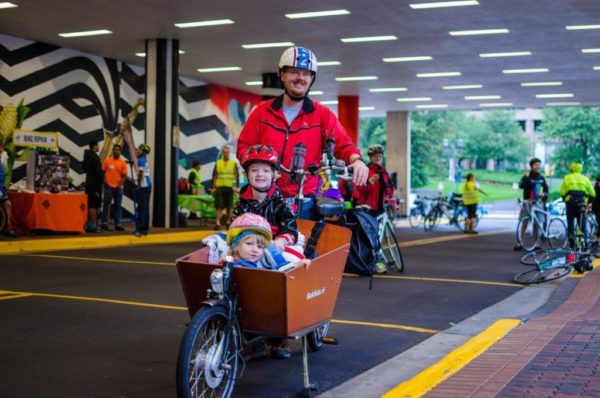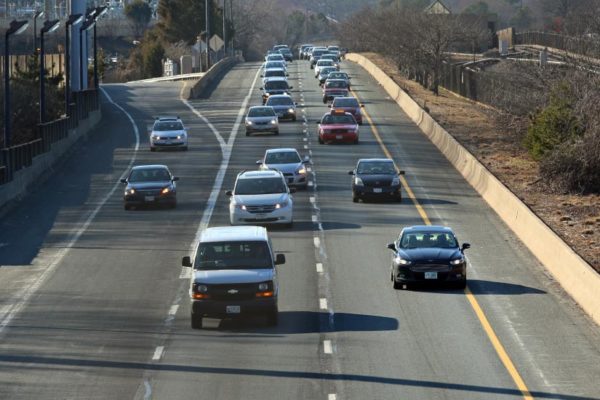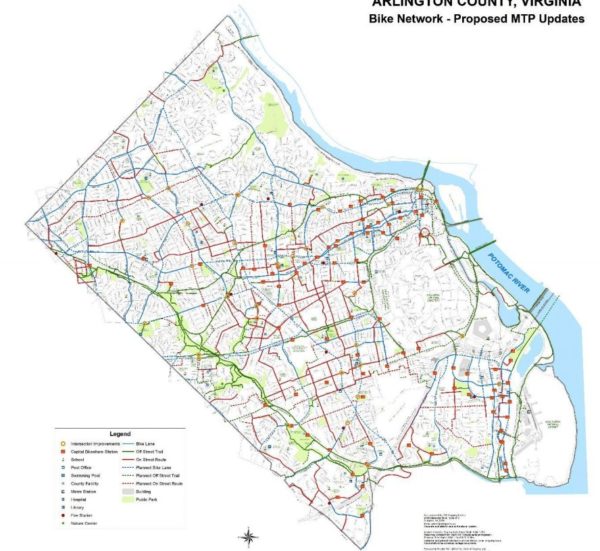Arlington County is currently working through a plan to add more options for housing through zoning changes, but there was disagreement during a recent Transportation Commission meeting over whether greater diversity of housing types will actually help with affordability.
Staff at the Transportation Commission noted that what’s being built these days are typically either condos and apartments or huge single-family homes. Townhouses and smaller, “starter” homes are more rare, resulting in a shrinking supply of housing accessible to young families.
“Neighborhoods are changing,” staff said. “Even without any intervention that will continue to change. New construction is either very large homes or smaller units in Metro corridors. Only 6% are three bedrooms or more, and that creates some tension as people seek to find housing for growing families.”
While affordable, mid-size units are in demand, the most lucrative options for developers are the higher-priced, luxury housing. Without some sort of intervention, staff said the neighborhoods will continue to become more expensive.
A framework for the Missing Middle Housing Study released in late December said the goals of the plan are:
- A shared definition for the term “missing middle housing” for Arlington
- A set of policy options to support preservation of existing Missing Middle housing stock and production of new Missing Middle housing types for County Board consideration
- Identification of additional considerations relating to the Comprehensive Plan and other County policies and practices to be further reviewed in support of the goals of this process
- The ability for new housing type alternatives to be built that meet Arlington’s definition of ‘missing middle housing”, offering greater affordability and design that is complementary and compatible with the scale and style of their intended neighborhoods
Part of that framework also dealt with “locational factors” for missing-middle housing.
“Building more housing… where people shop and work and have easy access to transit is one of the few things we can do in a small community to lessen our carbon impact,” said Transportation Commission member Chris Yarie. “Really drive the pedal down on that a lot, please.”
Transportation Commission member Audrey Clement was more wary of the plan, saying that it calls to increase types of housing but says nothing about affordability or equity. Instead, Clement echoed concerns of some in Arlington that the plan is an effort to quietly curtail single-family zoning.
“This is about the densification of the county and further gentrification of the county,” Clement said. “Given that is implied in the goals, to implement such a plan would require upzoning. Therefore it is disingenuous to say this is not about upzoning because that’s precisely what would be required to increase housing in residential neighborhoods.”
Clement pointed to the Veitch Street home to be replaced by several townhouses, discussed earlier in that same meeting.
“We’re really replacing every million-dollar home with up to seven million-dollar homes on residential lots,” Clement said. “That will serve the purpose of densifying the county, but it won’t provide more affordable housing and it’s a misnomer to call this a Missing Middle plan.”
Clement’s concerns are echoed by Arlingtonians for Our Sustainable Future, a group “concerned about Arlington County’s accelerated population growth and density” and its effect on water infrastructure, schools and transportation systems.
Plans to build seven new townhouses on N. Veitch Street in the Colonial Village are are moving forward, replacing a farmhouse built in 1920.
Seven townhouses would fill the parcel of land at 1731 N. Veitch Street, each four-stories tall. The new townhouses aren’t part of the Colonial Village development but are considered part of the Colonial Village neighborhood.
The homes are planned to face north and south with a 26-foot setback from the street. In the rear of each building will be a rooftop deck, a balcony on the second floor, and a two-car garage connected to the existing Colonial Village parking lot.
The plans were reviewed last night (Thursday) by the Transportation Commission, where most of the dissent on the project stemmed not from transportation issues, but preservation.
While not typically in the purview of the Transportation Commission, Commissioner Audrey Clement raised concerns about the historic nature of the building being replaced. The staff report notes that the existing single-family farmhouse on the property was constructed a century ago.
“This is a historic property,” Clement said. “The [Historic Affairs and Landmark Review Board] was not tasked to hear this item and I want to know why.”
A staff report said the development did go to the HALRB in June, but only as an informational item to receive feedback that led to some redesigns. While the property is surrounded by Colonial Village, which is designated as a historic district, the property itself is not marked as historic and feedback from the HALRB focused on keeping the design compatible with other nearby historic properties.
The townhouses were approved in an 8-1 vote by the Transportation Commission, with Clement voting against the project. The project is scheduled to go to the Planning Commission on Monday, Feb. 10, before being considered by the County Board.
Map via Google Maps
(Updated at 4:45 p.m.) Amazon plans to pay to completely revamp the “central park” next to its future HQ2, with a well-known designer at the helm.
The company and its architecture firm presented the latest plans for its permanent headquarters in Pentagon City to the Arlington Transportation Commission last night, ahead of an expected vote by the County Board on Dec. 14.
Amazon has offered to contribute a record $20 million to Arlington’s Affordable Housing Investment Fund, in exchange for being able to build the first half of its HQ2 bigger than otherwise would be permitted by zoning. The plans include two 22-story towers with a total of 2.15 million square feet of office and retail space.
Also of additional note is Amazon’s proposal for what is currently a modestly-sized and off-the-beaten-path park.
The second phase of HQ2 — the 500,000 square feet of temporary leased space in Crystal City is considered the first phase — would complete the “Metropolitan Park” development that includes four apartment buildings across from the Pentagon City Costco and along 12th Street S. Amazon is proposing to fund “a complete redevelopment of the park” in the middle of the buildings.
After expanding with an additional half acre of space from Amazon — not to mention a pair of new plazas totalling 20,000 square feet — the park will total more than 2 acres. But Amazon and Arlington County have grander plans for that space than the current park’s status as a defacto dog park for nearby apartment residents.
The county is expected to launch a master plan process for the park early next year, seeking community input on planned changes, according to Brian Earle, the lead architect of HQ2. Leading the design process will be James Corner Field Operations, the noted designer of New York City’s High Line.
Corner is “a real preeminent thinker about great urban space to help us realize the potential of that space,” Earle told the Transportation Commission.
Amazon will pay for the design, the public engagement process, the park construction and its maintenance, according to a draft site plan. The expected cost is $14 million, the Washington Business Journal reported.
Adjacent to the park and HQ2, meanwhile, portions of 14th Street and Elm Street are proposed to be flush with the sidewalk, making the streets, which will be open to traffic during business hours, more usable for events and other off-hours activities.
In front of HQ2, along S. Eads Street and extending to the Bartlett apartment building and Amazon-owned Whole Foods store, will be a “linear park.” The thin strip of parkland from 15th to 12th streets would include trees, string lights and cafe seating for the retail space at the base of Amazon’s towers.
The draft site plan describes “café seating associated with retail spaces, passive seating, public art, or programming” to “create open, flexible spaces for seating to encourage social activity” as part of the linear park.
New projects approved by the Northern Virginia Transportation Commission (NVTC) could improve some bus offerings around Arlington.
The Commonwealth Transportation Board voted yesterday (Wednesday) to use nearly $20 million in toll revenue to fund commuter projects along I-66.
“We [will] fund 13 projects that will provide connections to places people want to go, add options for commuter and local bus riders, encourage ridesharing and make it easier to choose transit,” said NVTC Executive Director Kate Mattice in a press release. “The projects funded through I-66 Commuter Choice will save Northern Virginia commuters approximately 485,000 hours of travel delay each year and move over 3,000 additional people through the corridor during rush hour.”
Additional bus trips are funded for some of Arlington’s major commuter destinations:
- Metrobus 3Y: Lee Highway-Farragut Square — The $1 million project will increase the frequency of Metrobus 3Y, a peak-direction route that operates between the East Falls Church Metro and downtown D.C. via Lee Highway (I-66).
- OmniRide Express: Gainesville-Pentagon — The $4.7 million project will add three new buses and eight total trips to the route from Gainesville to the Pentagon. The route averages 300 riders daily, according to the project description, and connects riders to multiple Metro lines.
- OmniRide Express: Haymarket-Rosslyn — The $776,700 project would add a new express bus between Haymarket Park and Ride lot to the Rosslyn-Ballston corridor. The lot was built in December and offers 230 parking spaces.
- New Bus: Stone Ridge-Pentagon — The $1.3 million project would fund a new bus line running from Stone Ridge II Park near Dulles to the Pentagon. The route will feature two morning and two evening peak-direction trips.
Five other bus routes enhanced or newly funded would pass from the outlying suburbs into D.C. along I-66.
The NVTC also agreed to spend $1.4 million to support I-66 marketing and outreach efforts of Arlington County Commuter Services — an agency that works to reduce traffic congestion and parking demand through programs like BikeArlington and The Commuter Store. The project will be continued for another three years.
“The approved projects for the FY 2020 Commuter Choice program provide connections to key destinations, address the needs of commuter and local bus riders and encourage commuters to use transit, carpools and vanpools,” the NVTC said in a report.
If the Avengers were a local enterprise, Chris Slatt would be the Guardian of the Arlington Transportation Galaxy.
Slatt serves as the Chair of the Transportation Commission and has a steel trap memory for county transportation projects — and the politicking behind why some never happened.
He’s weighted in on toll enforcement, infrastructure planning, and he’s organized everything from a protest for bicycle safety on the Pike to the cutest free library in Penrose with tools to fix your bike.
For this episode of the 26 Square Miles podcast, we sat down with Slatt to talk about why the Columbia Pike-Crystal City streetcar never took off, what Amazon means for local public transportation, and what it would really take to build safe bike routes across the county.
Listen below or subscribe to the podcast on iTunes, Google Play, Stitcher or TuneIn.
Photo via Jas Sanchez Photography
Virginia needs to do more to catch people evading tolls, county officials said at an Arlington Transportation Commission meeting last Thursday.
Virginia Department of Transportation officials attended the meeting, with plans to boast about boosted speeds on I-66, but local officials were more concerned about what some saw as underenforcement of High Occupancy Vehicle (HOV) rules.
David Caudill, the division administrator for tolling for VDOT, explained that the current enforcement relies on Virginia State Police counting heads in passing cars in conjunction with checking a beacon that lights up on a gantry if the passing car registered as HOV.
But Commission member Audrey Clement said that fewer people are receiving citations for I-66 toll violations than would be even if there were a 99 percent toll-compliance rate.
“There were 702 HOV citations for a year, that averages to 2.7 citations for every eight hours of tolling. That’s three per day,” said Clement. “So we’re concerned that this phenomenon is being undercounted and underenforced, and that may be driving up tolls.”
According to VDOT staff, there are at least four state troopers assigned to enforcement on I-66 every day. Rather than just being able to focus on HOV rules, however, troopers also respond to emergency calls and traffic violations like speeding.
Caudill recognized that there is a lapse in toll enforcement and said that during enforcement “blitzes” the HOV usage rates drop by 3 percent, giving VDOT a rough estimate for how many drivers are ducking out of the toll.
“It’s a challenge, I’ll admit that,” Caudill said. “[It is] challenging to look at the light, count number of heads, and then chase them down… We’re not catching everyone, not by any means.”
VDOT staff said the group is partnering with Transurban to put together a pilot program for an electronic sensor system.
“We think there’s an opportunity there for better enforcement,” Caudill said, “[and] it does impact the tolls, probably.”
Clement was not alone in expressing her disappointment at the lack of enforcement. Chris Slatt, chair of the Transportation Commission, said the lapse in enforcement goes against what VDOT told Arlington when the toll lanes were first proposed
“When VDOT was here before tolling went into place, one of the main reasons presented [to us] was HOV violations were rampant then,” Slatt said. “We were told that this was going to be the solution to HOV violation problem, that we were going to do enforcement. And yet here we are, having this conversation again.”
Caudill said the new HOV lanes have also led to complications — for instance, electronic passes mean officers can’t get an estimate on toll-violators by just counting heads.
“I’m glad to hear pilot programs at least are in the works to try to get a handle on this, because HOV violators are slowing down legitimate HOV drivers,” said Slatt. “[They’re] driving up costs of people legally paying tolls, and taking money that could be used for multimodal transportation projects to keep us all moving.”
Arlington transportation planners’ latest attempt at crafting the future of the county’s cycling infrastructure has left neighbors, bicyclists and environmental advocates both pleased and disappointed.
The first draft of the 5o-page document, known as the bicycle element of the county’s Master Transportation Plan, originally included 26 cycling infrastructure projects including new trails and on-street bikeways. Since then, county staff has cut a few bike trails from the document, including two major projects: the Arlington Hall trail in Alcova Heights and another connecting the former Northern Virginia Community Hospital in Glencarlyn to Forest Hills, which were chopped after outcry from neighbors and environmentalists.
Still, bike advocates expressed broad support for the plan, but some think the latest draft doesn’t go far enough to ensure pedestrian safety and combat climate change.
“We made a number of changes in response to what we heard,” said Richard Viola, the project manager for updating the plan at the transportation division of the Department of Environmental Services (DES) told ARLnow Thursday. “I don’t think it negatively affects the overall plan, but it certainly shows a little more consideration of our natural resources.”
The plan is a sort of guiding “wish list” for the county, which some refer to as the “Master Bike Plan.” Viola’s group has been revising the document for more than a year, with the final version expected to be adopted later this spring. The latest edition will be posted publicly next week, he said.
During this latest revision, the county dropped its proposal for an off-street, half-mile trail connecting 6th Street S. to S. Quincy Street in the Alcova neighborhood at S. Oakland Street. The trail became a point of controversy because it could mean 6th Street residents lose some backyard privacy, and the county would cut down some important trees.
“We heard from a number of people from that Alcova Heights neighborhood that they did not want to see the trail built,” said Viola. “And then later we heard from a number of people in the neighborhood who want to see the trail build.” Ultimately, his working group shelved the Alcova trail idea for another time.
Another nixed idea was to extend the Four Mile Run Trail a half mile to connect with Claremont Elementary and Wakefield High. The Audubon Society wrote a letter in January warning that the proposal could cause “potential harm” to the rare magnolia ecosystem in the area.
“It’s a useful connection,” Viola said of the proposed trail. “People walk it today. But it would not be a suitable bike route when we thought about it because of the steepness [of the trail] and the proximity to this magnolia bog natural preserve.”
Another plan that became bogged down was a Glencarlyn/Hospital Trail connecting Glencarlyn and Forest Hills neighborhoods via the old site of the Northern Virginia Community Hospital. The half-mile project was envisioned by Viola’s team as a “low-stress route” between Arlington Boulevard and Columbia Pike because it could link up with other bikeways on S. Lexington Street, S. Carlin Springs Road, and 5th Road S.
The Audubon Society wrote that a trail passing through the old hospital site would “destroy valuable natural resources” in the conservation area that protects Long Branch Creek.
As a compromise, Viola’s team suggested instead widening the sidewalk on the east side of Carlyn Springs Road, so bikes and pedestrians can share.
“There are other comments they did not address in their plan,” said Audubon Society member Connie Ericson, referring to the organization’s January letter. “But we are pleased that they took some of our suggestions.”
However, members of the Arlington County Transportation Commission were “not wild” about the sidewalk idea, according to Commission Chair Chris Slatt.
Slatt told ARLnow Friday morning that members felt a paved, woodsy trail was too rare an opportunity pass up.
“There aren’t a lot of places where you could jog or bike without cars next to you,” he said. “It would seem like a shame to give up on that.”
In general, the plan drew praise from Ericson, and other advocates like D.C.-based Wash Cycle who said they couldn’t “spot any holes in the plans” in a January blog post.
Bruce Deming, who runs the Law Offices of Bruce S. Deming, Esq. and is known as the “Bicycle Lawyer,” also praised the Master Bike Plan for being “very thorough” and having a “cohesive strategy.” But he also told ARLnow in a phone call that, when it comes to safety, the “sense of urgency should be greater” in the latest draft.
The plan contains no mention of speed cameras — something Deming admitted is “politically unpopular” but reduces the injury and mortality rates in crashes with pedestrians and cyclists.
Deming also critiqued the plan for not prioritizing more bike lanes protected from cars, something 64 percent of respondents surveyed by the county wish for according to the Master Plan.
“According to the latest version of the plan, we’ve got 29 miles of bike lanes and 10 percent are the protected bike lanes,” said Deming. “I’d like to see that percentage increase substantially.”
Viola told ARLnow that the plan has been updated to language about “traffic safety education.”
The updates to Arlington’s Master Bike Plan are the first in 10 years, and according to Viola, the county doesn’t expect to undergo the process again for another decade. This comes a few months after the U.N.’s report indicating humans have 12 years to cut emissions before global warming causes permanent ecological damage, and reducing trips by car is one way to do this.
The Master Bike Plan acknowledges this, writing that improving the county’s pledges to improve air quality and reduce its emissions “depend greatly on shifting more travel to energy-efficient travel modes such as bicycling and walking.”
For Slatt, this means ensuring the infrastructure is so good it makes people want to ditch cars for bikes — something that would be easier to figure out how to do if the county allocated more resources and invested in high-end data analysis.
“People don’t people pick their transportation option because it saves the planet,” he said. “People pick their transportation option because it works for them because it’s faster or cheaper or makes them happy.”
Arlington officials say the first month of the county’s dockless vehicle pilot program has largely gone smoothly, though enforcing rules about where to ride the pervasive electric scooters remains a challenge.
Two companies — Lime and Bird — have been offering their dockless scooters around Arlington ever since the County Board signed off on a “demonstration project” for the vehicles in late September. Though Bird previously operated in the county without any explicit government involvement, the Board’s pilot program was designed to set some standards for dockless vehicles and allow companies to operate hundreds in the county at a time.
County commuter services bureau chief Jim Larsen told the Transportation Commission last Thursday (Nov. 1) that two more scooter companies could soon enter Arlington as well: Skip and Lyft, which only recently began offering scooters in addition to its ridesharing service.
Then, by January, Larsen expects that Jump could also make the move from D.C. into Arlington and offer both electric bikes and scooters in the county.
“The dynamics of this change weekly, if not daily,” Larsen told the commission.
Larsen added that, since Oct. 1, county police have responded to a total of nine crashes involving scooter riders, though he noted that there’s been “nothing major” among the accidents so far.
Still, one of those incidents did involve a student riding a scooter who was struck while in a crosswalk, Larsen said. The scooter companies generally ban anyone under the age of 18 from riding the vehicles, and Larsen said the county is working closely with the school system to make that clear to students.
Larsen also noted that the top public complaints the county has received about the program relate to “illegal sidewalk and train riding, improper parking, unsafe riding, underage riders and speed.”
Those were concerns echoed by Transportation Commissioner Audrey Clement, who noted that she’s seen teenagers riding scooters without helmets on the Custis Trail in the past, which would make for three violations of the county’s policies.
“There’s no way you could even ask Arlington Police to monitor the length of the Custis Trail or any of the trails in this county,” said Clement, who is also mounting an independent bid for School Board this year. “Absent a realistic enforcement policy, this pilot program is both reckless and irresponsible.”
Larsen conceded Clement’s point, but did stress that county staff are working closely with both the dockless companies and police to ensure the safety of riders and drivers alike.
County police, meanwhile, also trying to spread the word about scooter safety as part of a broader traffic safety campaign this fall, and have even started using electronic signs reminding scooter riders to stay off sidewalks.
Others on the commission were less willing than Clement to attack the program’s legitimacy. Commissioner Jim Lantelme was interested in comparing the number of scooter-involved crashes to those involving bikes, noting that they “might actually be safer than bicycles or other methods” of getting around. Larsen, however, didn’t have such data available.
By and large, commissioners said they were satisfied with the program’s early results, and Larsen agreed. He noted that Bird and Lime have both done a “pretty good job” of balancing the number of scooters available in D.C., which has its own dockless pilot program, and Arlington.
Larsen praised Lime, in particular, for employing 21 people to monitor the scooters around the county and operating its own warehouse in Arlington.
“They’re really trying to go around and self-police,” Larsen said. “We’re really trying to push the operators to emphasize safety themselves.”
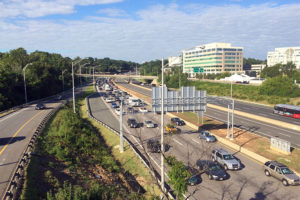 Locals will have a chance to learn about future travel choices along the I-395 corridor during a public meeting tonight.
Locals will have a chance to learn about future travel choices along the I-395 corridor during a public meeting tonight.
The Virginia Department of Rail and Public Transportation (DRPT) is scheduled to hold an open house prior to the Arlington Transportation Commission meeting at 2100 Clarendon Blvd from 6:30-7:30 p.m. this evening.
The purpose of the open house is to discuss an ongoing DRPT study designed to come up with a list of projects eligible for funding from revenue generated by the plan to extend the 395 Express Lanes to Eads Street in Arlington.
Those projects could include better bus or rail service, more carpooling options and other ways to “support mobility, economic development, and sustainability goals for communities along the corridor,” officials said. Virginia has committed at least $15 million per year to funding possible projects.
Locals can weigh in on the study before the meeting by completing this DRPT survey.
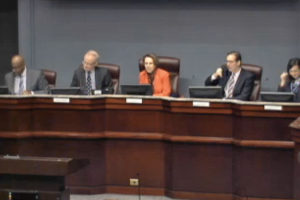 Arlington County is taking steps to make local government more open online.
Arlington County is taking steps to make local government more open online.
The County Board on Tuesday approved a pilot program to webcast Planning Commission and Transportation Commission meetings, as well as certain County Board work sessions.
“The goal of the new program is to engage more residents in the civic process who are not able or choose not to attend meetings,” the county said in a press release. “The goal is to increase awareness of County issues and ease participation for a more broad and diverse audience.
Meetings held in the County Board room will be broadcast using existing audio-visual equipment that’s used to air Board meetings. If the pilot program is successful, the county may expand the scope to include meetings held in other locations around Arlington.
A start date for the webcasts is expected to be announced soon.
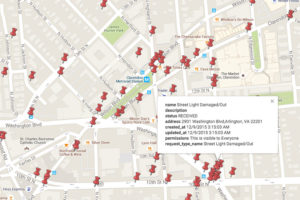 In a second initiative announced Tuesday, the county has launched a new “Open Data Portal” that includes various spreadsheets, charts and maps of government data.
In a second initiative announced Tuesday, the county has launched a new “Open Data Portal” that includes various spreadsheets, charts and maps of government data.
Among the info currently offered by the portal is a map of pothole and other service requests (pictured), restaurant health inspection records, real estate sale records, a map of car share locations, and a police incident log.
Some of the data is a bit dated — the real estate sale records, for instance, are only for 2015, and as of this writing the most recent crime records are from Feb. 17. On the plus side, there are also new tools for filtering, sorting and exporting data, along with an open API that may prove useful for analysis and for web and mobile application developers.
“New datasets from the County’s departments will be made available in the months ahead based on popular user requests and available resources,” the press release notes.
“Technology continues to improve our ability to share data and streamline processes for a more interactive and inclusive government,” County Manager Mark Schwartz said in a statement. “We will continue to seek out and implement tools like the data portal and web streaming that help us improve access to government and create a better overall user experience for our residents.”
“Our residents are busy people who cannot always make it to the County Board Room to sit through hours of discussion,” said Arlington County Board Chair Libby Garvey. “We want to make sure that they have another option – they can watch both Board work sessions and commission meetings on their computers, in the comfort of their homes, so that they can stay informed about important decisions that may affect their families and our community.”
“The County’s Open Government Program strives to achieve an open, accessible, efficient and transparent government,” said the press release. “The Open Data Portal and pilot webcast program are the latest efforts in serving and engaging the public more effectively.”



